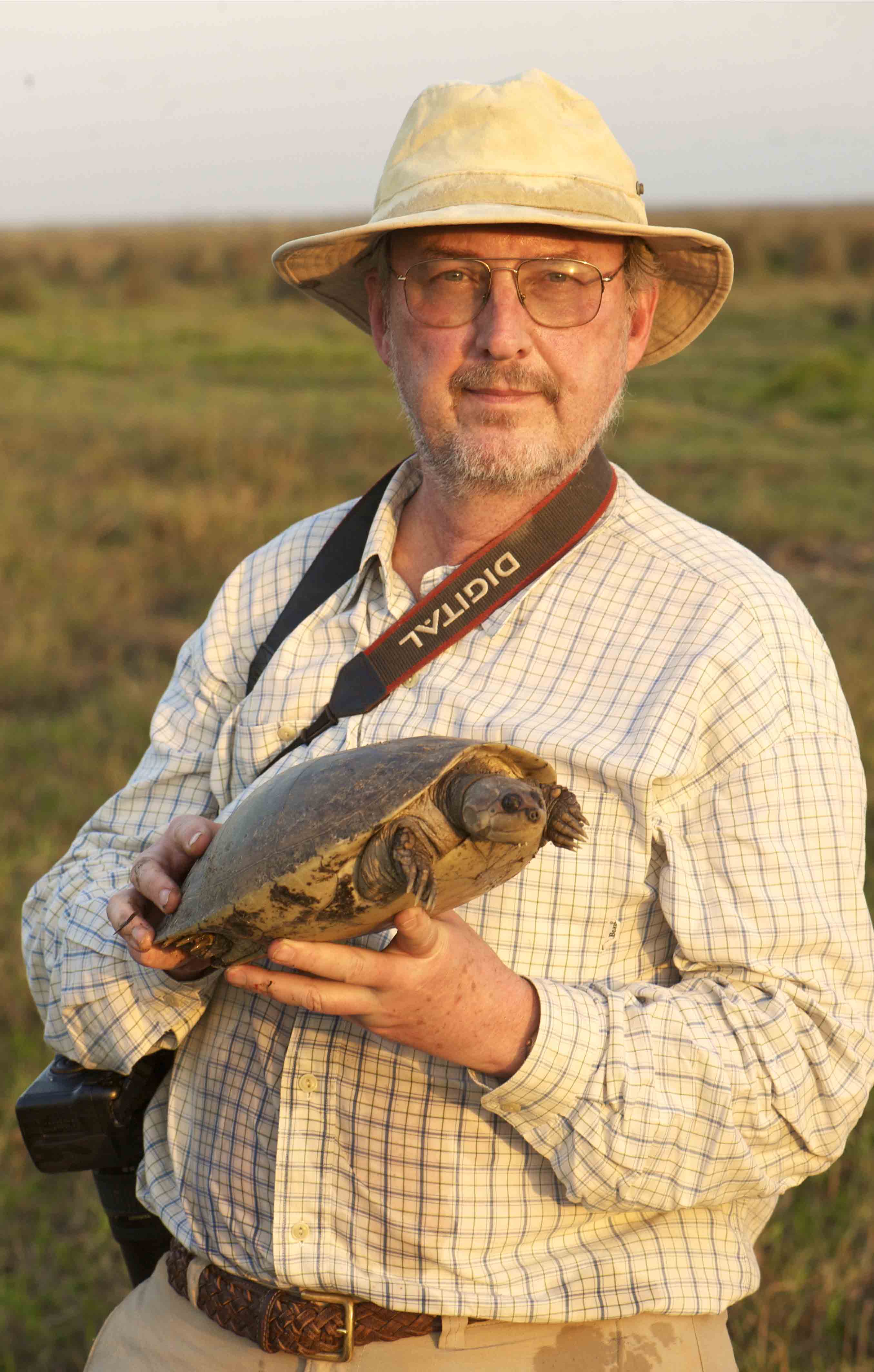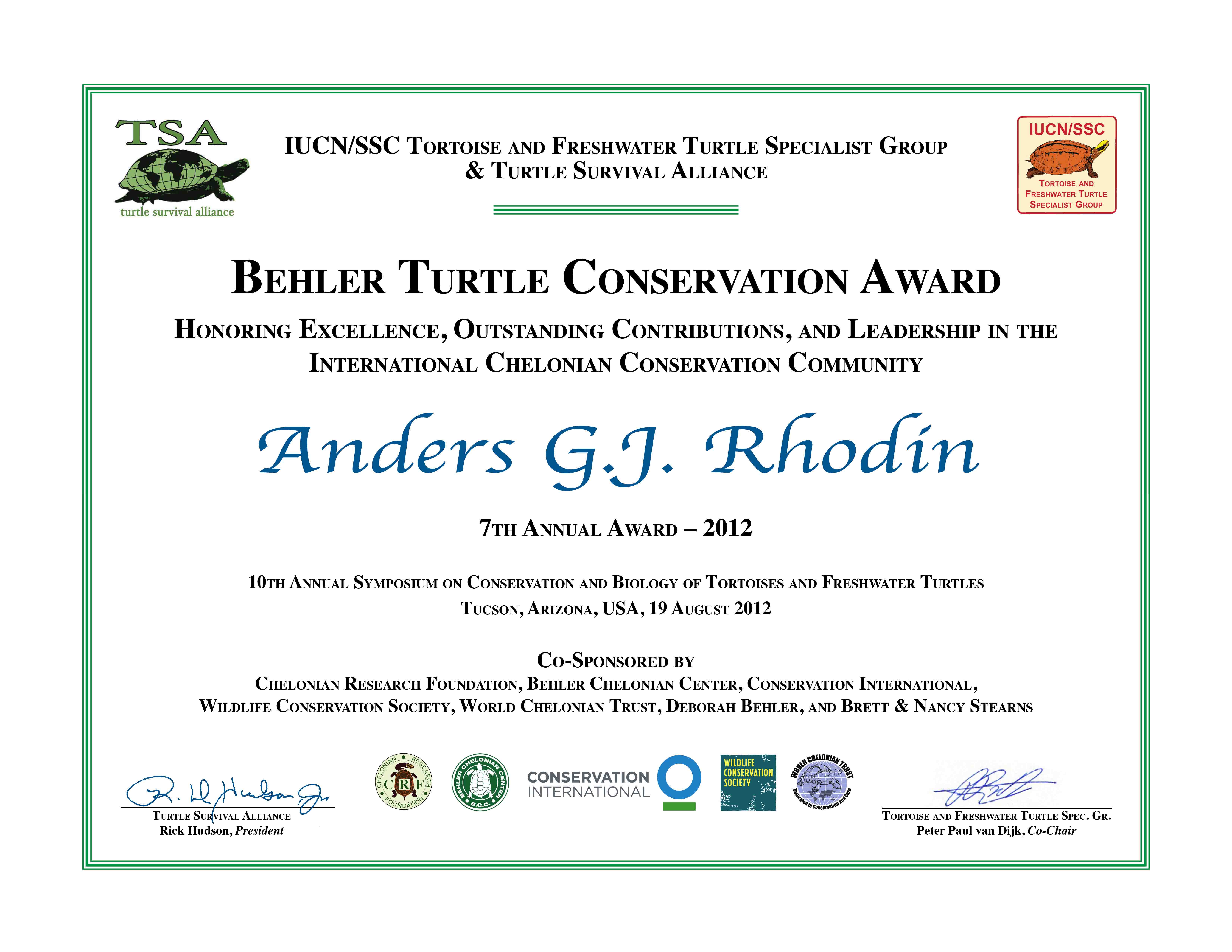Anders Rhodin
Anders Rhodin Receives the 7th Annual 2012 Behler Turtle Conservation Award

Anders G.J. Rhodin
Behler Award: Anders G.J. Rhodin – an Appreciation
by Russell A. Mittermeier and Peter Paul van Dijk
from Turtle Survival Magazine 2012:61–62.
(download pdf here)
Anders Rhodin was bornin Sweden but came to the United States when he was 8 years old. His undergraduate education was at Dartmouth College, where he and Russ Mittermeier were dormmates, friends, and co-adventurers, traveling together to the Amazon in 1971 in search of monkeys and turtles. There, on a canoe trip with Russ into the wilds along the Rio Negro, he was given a small pet tortoise by a native family—a gift that transformed his life as he became increasingly interested in caring for this animal and then learning as much as he could about turtles and tortoises. During this time it became evident that he had two professional passions: medicine and turtles, and a major career choice lay ahead. After sage advice from his M.D./Ph.D father, Johannes Rhodin, that a physician can always work on turtles on the side, but a turtle biologist can never be a part-time physician, he chose medicine as his primary career but kept herpetology and the study of turtles as a strong second professional avocation. He attended medical school first at the University of Göteborg in Sweden, then at New York Medical College, and ultimately received his M.D. degree at the University of Michigan. During this time he also spent considerable time working at the Department of Herpetology at the Museum of Comparative Zoology at Harvard University, under the informal mentorship of Ernest Williams, where he continued his collaborative turtle work with Russ Mittermeier.
He completed his medical training and worked for several months at a hospital in the interior highlands of Papua New Guinea. This not only fulfilled his medical training requirements, but also allowed Anders convenient access to the turtle fauna of New Guinea and led to the discovery and descriptions of the two new species Chelodina parkeri and C. pritchardi, as well as a series of publications on other turtles of the New Guinea region. Other taxonomic research on the side-necked turtles of the family Chelidae eventually led to the descriptions of another four new taxa from Roti, Indonesia, Timor- Leste, and South America (Chelodina mccordi, C. timorlestensis [now C. timorensis], Acanthochelys macrocephala, and Phrynops williamsi). Most of these were described in collaboration with Russ Mittermeier, but some were solo productions and others included other co-authors, including one with Gerald Kuchling.
After his medical school work, Anders completed an internship and residency program in orthopedic surgery at Yale University, where he also pursued comparative anatomical research on marine mammals and turtles with his mentor there, John Ogden. While at Yale he made the major discovery that leatherback turtles possess thick vascularized cartilages, a most unusual and important finding that he reported in the journal Nature, and he provided anatomic and histologic evidence for the mammalian-like rapid bone growth in leatherback turtles as well as several fossil marine turtles, including an important article on the electron microscopy of these cartilage canal vessels co-authored with his electron microscopist father, Johannes.
For several years he was also actively involved in the study of nesting and migrating leatherback sea turtles on Culebra, Puerto Rico, with Molly Lutcavage, bringing the latest orthopedic surgical techniques to bear on experimental satellite transmitter attachments to leatherback turtle shells.
More recently he has been the lead author of the annual checklist of turtles compiled by the Turtle Taxonomy Working Group, helping to establish a common baseline for turtle research as well as attempting to stabilize and standardize nomenclatural and taxonomic issues concerning turtles. Over the length of his career from the early 1970s until now, he has published about 175 articles on turtles and tortoises and co-edited several books.
Anders established Chelonian Research Foundation (CRF) in 1992 to produce, publish and support worldwide tortoise and turtle research, with an emphasis on the scientific basis of chelonian diversity and conservation biology. His love of books and journals and his editorial skills, combined with the need for a dedicated publication venue for scholarly articles on the biology and conservation of turtles, inspired him to establish the professional peer-reviewed journal Chelonian Conservation and Biology (CCB) in 1993. The journal has been a major success and has at times achieved one of the highest ISI impact factors of any herpetological journal worldwide. Every issue is eagerly awaited by turtle researchers and conservationists, and pdf’s whiz across email networks soon after publication. Publication management of CCB was transferred to Allen Press a few years ago, clearly demonstrating how frugal and economical Anders was when its production and distribution were managed in-house solely by himself.
In addition, CRF publishes the occasional series Chelonian Research Monographs (CRM), including the loose-leaf Conservation Biology of Freshwater Turtles and Tortoises (CBFTT) accounts, and the Turtle and Tortoise Newsletter (TTN) from 2000 to 2011. Both CBFTT and TTN are open access and freely downloadable by anyone worldwide. The CRM series has produced such important works as the Galapagos Tortoises by Anders’ friend and co-traveler Peter Pritchard, and the Asian Turtle Trade co-edited with his friends and collaborators Peter Paul van Dijk and Bryan Stuart. The latter volume became the clarion call and best-documented source identifying the rapidly expanding consumptive turtle trade in Asia, and was used by CITES as its roadmap for improving trade regulations in the region in an effort to control and minimize the devastating damage to turtle populations caused by this trade.
Through Chelonian Research Foundation, Anders has also provided direct support for turtle research and conservation through his personal Linnaeus Fund, named in honor of the Swedish founder of modern systematics who also described turtles over two centuries earlier. Over the 20 years of the Fund’s existence to date, it has funded 118 projects around the world for over $140,000 in support.
Anders Rhodin devotes much of his time and efforts to working with others in the turtle conservation community, both marine and terrestrial and freshwater. He has been a longterm member of the IUCN/SSC Marine Turtle Specialist Group and was a Board Member of the International Sea Turtle Society. He was a founding member of the IUCN/SSC Freshwater Chelonian Specialist Group in 1981, and served as Deputy Chair of the combined Tortoise and Freshwater Turtle Specialist Group (TFTSG) from 1991–2000, as Co-Chair with John Behler during 2000–2005, and as Chair from 2005 to 2012. He was instrumental in helping to establish the Turtle Survival Alliance (TSA) in 2001 with Rick Hudson, Kurt Buhlmann, and others, and the Turtle Conservation Fund (TCF) in 2002 with Russ Mittermeier, Walter Sedgwick, Kurt Buhlmann, Rick Hudson, and others, and continues to serve on the Board of Directors of these organizations, currently Co-Chairing the TCF with Hugh Quinn, as well as being a Chairman’s Council member of Conservation International with Russ Mittermeier, and a Board member of the Turtle Conservancy with Eric Goode.
He has also been a member of a variety of IUCN and CITES leadership committees, including the Steering and Red List Committees of the Species Survial Commission with Simon Stuart and Jeff McNeely and the Advisory Board of the Mohamed bin Zayed Endangered Species Conservation Fund with Russ Mittermeier. In February of this year, the IUCN Species Survival Commission honored him for his long-standing efforts on behalf of turtle and tortoise conservation by presenting him with the Sir Peter Scott Award for Conservation Merit, the most senior SSC award.
Of particular note have been his continuous efforts to build a series of comprehensive, coordinated and strategic alliances among the various organizations and individuals engaged in turtle conservation, including the establishment of the Turtle Conservation Fund and the Turtle Conservation Coalition. Equally noteworthy is his appreciation of the role that policy and laws can play in turtle conservation, and his resulting tireless engagement with and support for efforts to extend the protection of CITES and United States federal laws to tortoises and freshwater turtles.
Throughout his lifetime of involvement with turtle biology and conservation, Anders Rhodin has placed collaboration and encouragement at the core of his activities. He has seen himself as being a facilitator and an organizer, as well as a cheerleader, devoted to helping bring the international turtle community closer together and to growing an increasingly effective ground-swell of support and action and inspiring it to reach new heights of collaboration and success in its efforts. His signature advice to all of us in the turtle conservation community, in his oft-repeated poetic litany inspired by Robert Frost, has always been that “we must work together, I tell you from the heart, whether we work together, or apart.”
Engaging and empowering promising young scientists at home and abroad has also been, and continues to be, a hallmark of his career and a foundation for his CRF Linnaeus Fund annual turtle grants. In addition, Anders and CRF have encouraged student scholarship by funding Student Presentation Awards for many years at both the International Sea Turtle Symposium and more recently at the Annual Symposium of the Turtle Survival Alliance and the TFTSG.
This past year, in order to devote more time and effort to his practice of orthopedic surgery as well as to his personal life and interest in his roots in Sweden, Anders began a process of gradually stepping down from his various turtle endeavors. He transferred CCB editorial responsibilities to Jeff Seminoff, Jeff Lovich, and Peter Lindeman, and stepped down from his position as TFTSG Chair to encourage Peter Paul van Dijk and Brian Horne to become Co-Chairs, and resigned from the IUCN/SSC Steering Committee. He did this with the clear understanding that the best time to step down is when one is still at the peak of one’s abilities and still able to mentor and shepherd new leadership into positions of influence. By facilitating the next generation of turtle people into conservation and editorial leadership, as Chairman Emeritus of the TFTSG, and by remaining a Board member of many of the organizations he helped found and support, his guidance and influence will continue to validate his outstanding achievements as an inspiring turtle conservation and research leader.









